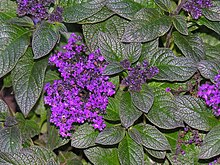Heliotrope (plant)
| Heliotropium | |
|---|---|
 |
|
| Heliotropium arborescens | |
| Scientific classification | |
| Kingdom: | Plantae |
| Clade: | Angiosperms |
| Clade: | Eudicots |
| Clade: | Asterids |
| Order: | Boraginales |
| Family: | Boraginaceae |
| Subfamily: | Heliotropioideae |
| Genus: |
Heliotropium L. |
| Type species | |
|
Heliotropium europaeum L. |
|
| Species | |
|
250-300, see text |
|
| Synonyms | |
|
Beruniella Zakirov & Nabiev |
|
250-300, see text
Beruniella Zakirov & Nabiev
Bourjotia Pomel
Bucanion Steven
Cochranea Miers
Euploca Nutt.
Lithococca Small ex Rydb.
Meladendron Molina
Parabouchetia Baill.
Valentina Speg.
Heliotropium /ˌhiːliəˈtroʊpiəm, -lioʊ-/ is a genus of flowering plants in the borage family, Boraginaceae. There are 250 to 300 species in this genus, which are commonly known as heliotropes (sg. /ˈhiːli.ətroʊp/).
The name "heliotrope" derives from the old idea that the inflorescences of these plants turned their rows of flowers to the sun. Ἥλιος (helios) is Greek for "sun", τρέπειν (trepein) means "to turn". The Middle English name "turnsole" has the same meaning.
Several heliotropes are popular garden plants, most notably garden heliotrope (H. arborescens). Some species are weeds, and many are hepatotoxic if eaten in large quantities due to abundant pyrrolizidine alkaloids. There have been cases of canine death due to over-ingestion of this toxic plant. Some danaine butterflies, such as male queen butterflies, visit these plants, being attracted to their pyrrolizidine alkaloids Though it is not palatable and most animals will completely ignore it, there have been cases of horses, swine and cattle being poisoned due to contamination of hay.
...
Wikipedia
